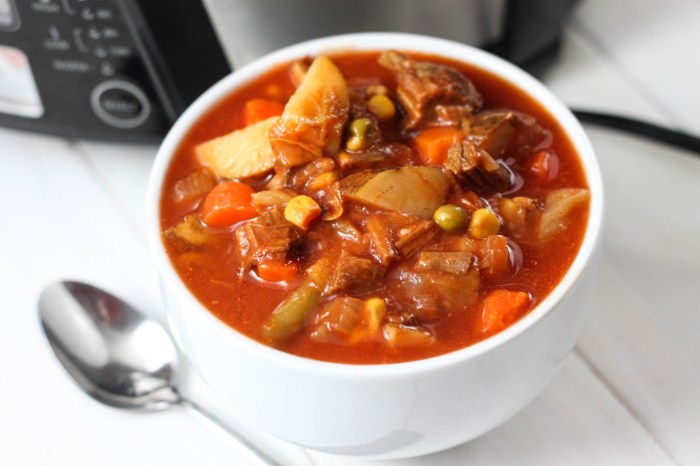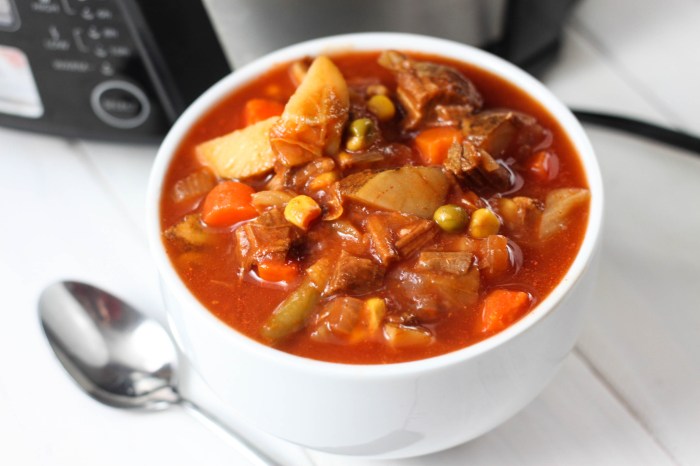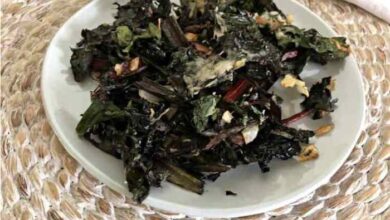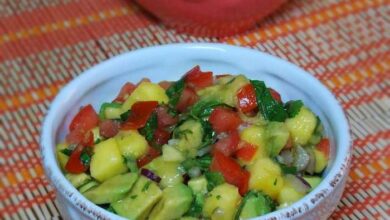
Homemade Vegetable Beef Soup: A Comforting Classic
Homemade vegetable beef soup is a comforting classic that warms the soul on a chilly day. It’s a dish that evokes memories of childhood dinners and family gatherings, and it’s always a welcome sight on the table. I remember my grandma’s version, a rich and hearty broth filled with tender beef, colorful vegetables, and a hint of warmth that made you feel instantly cozy.
Beyond its nostalgic appeal, homemade vegetable beef soup offers a plethora of benefits. You have complete control over the ingredients, ensuring freshness and quality. The versatility of this soup allows for endless variations, making it adaptable to dietary needs and preferences.
Whether you’re craving a hearty meal or a light lunch, homemade vegetable beef soup is always a satisfying choice.
Homemade Vegetable Beef Soup
There’s something undeniably comforting about a warm bowl of homemade vegetable beef soup. It’s a classic dish that has been enjoyed for generations, and for good reason. Its hearty flavors and satisfying textures make it perfect for a chilly evening or a lazy weekend afternoon.
I have fond memories of my grandmother’s vegetable beef soup, the aroma of simmering beef and vegetables filling the kitchen, a symphony of flavors that always brought the family together. Making vegetable beef soup at home offers a unique advantage: control over the ingredients.
You can choose the freshest, highest-quality vegetables and lean beef, ensuring a healthier and more flavorful soup. The process of simmering the soup for hours allows the flavors to meld and deepen, creating a rich and complex broth.
Ingredients
The foundation of a delicious vegetable beef soup lies in its ingredients. Choosing the right combination of beef, vegetables, and broth creates a hearty and flavorful dish. While the classic recipe offers a solid starting point, there’s ample room for customization with optional ingredients that enhance the soup’s taste and texture.
Essential Ingredients
A classic vegetable beef soup typically includes a variety of ingredients that contribute to its richness and complexity. These essential ingredients form the base of the soup and provide the foundation for flavor.
| Ingredient | Type | Function | Variations |
|---|---|---|---|
| Beef | Meat | Provides protein, richness, and depth of flavor | Chuck roast, short ribs, ground beef |
| Vegetables | Produce | Adds texture, color, and nutritional value | Carrots, celery, potatoes, onions, tomatoes, green beans, corn |
| Broth | Liquid | Provides the base for the soup and adds flavor | Beef broth, vegetable broth, chicken broth |
Optional Ingredients
Beyond the essential ingredients, there are numerous optional ingredients that can be added to enhance the flavor and complexity of the soup. These additions can be tailored to personal preferences and dietary needs, creating a unique and personalized dish.
| Ingredient | Type | Function | Variations |
|---|---|---|---|
| Herbs | Spice | Adds aroma and depth of flavor | Thyme, rosemary, parsley, bay leaf, oregano |
| Spices | Spice | Enhances the flavor profile of the soup | Black pepper, garlic powder, onion powder, paprika |
| Beans | Legume | Adds protein, fiber, and texture | Kidney beans, pinto beans, black beans, chickpeas |
Preparation
Preparing the ingredients for this soup is a straightforward process, and the cooking itself is relatively simple. Here’s a step-by-step guide to make your own homemade vegetable beef soup.
Preparing the Ingredients, Homemade vegetable beef soup
Before starting the cooking process, it’s important to prepare the ingredients. This includes cutting the vegetables and browning the beef.
- Cut the vegetables:Wash and cut the vegetables into bite-sized pieces. The exact size will depend on your preference, but generally, aim for pieces that will cook evenly in the soup.
- Brown the beef:Heat the oil in a large pot or Dutch oven over medium-high heat. Add the beef and cook, stirring occasionally, until browned on all sides. This will add flavor to the soup.
- Prepare the broth:If using homemade broth, you can prepare it in advance or use store-bought broth. For a richer flavor, use beef broth.
Cooking the Soup
Once the ingredients are prepared, you can begin cooking the soup. This process involves simmering the ingredients in the broth until the vegetables are tender and the flavors meld.
- Sauté the aromatics:Add the onions, carrots, and celery to the pot with the browned beef. Sauté for about 5 minutes, or until the vegetables have softened. This will enhance the flavor of the soup.
- Add the broth and seasonings:Pour the broth into the pot, add the tomato paste, salt, pepper, and any other desired seasonings. Bring the mixture to a boil, then reduce heat and simmer for 30 minutes.
- Add the vegetables:After 30 minutes, add the potatoes, corn, and green beans to the pot. Simmer for another 15-20 minutes, or until the vegetables are tender.
- Add the noodles:If using noodles, add them during the last 5-10 minutes of cooking.
- Serve and enjoy:Ladle the soup into bowls and serve hot.
Cooking Techniques

Vegetable beef soup can be cooked using various methods, each with its own advantages and disadvantages. The most common methods include stovetop simmering, slow cooking, and pressure cooking. Let’s explore the pros and cons of each technique to help you decide which method best suits your needs and preferences.
Comparison of Cooking Methods
Choosing the right cooking method depends on factors such as your desired cooking time, flavor profile, and ease of preparation. Here’s a table summarizing the advantages and disadvantages of each method:
| Method | Advantages | Disadvantages |
|---|---|---|
| Stovetop Simmering |
|
|
| Slow Cooking |
|
|
| Pressure Cooking |
|
|
Serving and Storage
A steaming bowl of homemade vegetable beef soup is a comforting and satisfying meal, perfect for a chilly evening or a hearty lunch. Serving it with the right accompaniments and storing any leftovers properly will ensure you enjoy this delicious soup to the fullest.
Serving Suggestions
The ideal way to serve homemade vegetable beef soup is in a warm, inviting bowl. Here are some serving suggestions that will elevate your dining experience:
- Crusty Bread:A slice of crusty bread, toasted or untoasted, is a perfect companion to the soup. The bread can be used to soak up the flavorful broth and provide a contrasting texture.
- Crackers:A variety of crackers, such as saltines or wheat crackers, can add a crunchy element to the soup. They also work well for dipping into the broth.
- Sour Cream or Yogurt:A dollop of sour cream or yogurt adds a tangy and creamy touch to the soup, balancing the richness of the beef and vegetables.
Storing Leftover Soup
Properly storing leftover soup is essential to maintain its quality and flavor. Here’s how to store your homemade vegetable beef soup:
- Storage Container:Use an airtight container, preferably made of glass or food-grade plastic, to store the soup. This will prevent air from getting in and spoiling the soup.
- Refrigeration:Refrigerate the soup within two hours of cooking. It can be stored in the refrigerator for up to 3-4 days.
- Freezing:For longer storage, you can freeze the soup. Transfer the soup to freezer-safe containers, leaving some space at the top for expansion. The soup can be frozen for up to 2-3 months.
Reheating Soup
When you’re ready to enjoy your leftover soup, reheating it properly is crucial. Here’s how to do it:
- Stovetop:Transfer the soup to a saucepan and heat it over medium heat, stirring occasionally, until it’s warmed through. Avoid boiling the soup, as this can cause the vegetables to become mushy.
- Microwave:Reheat the soup in a microwave-safe bowl, in 30-second intervals, stirring after each interval, until it’s heated through.
Variations and Adaptations
This hearty and flavorful soup is a classic comfort food, and there are many ways to customize it to suit your taste buds and dietary needs. Whether you’re looking to make it vegetarian, vegan, gluten-free, or low-sodium, there are simple substitutions and adjustments that can be made to create a soup that’s perfect for you.
Vegetarian Variations
Vegetarian variations of vegetable beef soup can be made by replacing the beef with plant-based protein sources. Here are a few options:
- Lentils:Lentils are a great source of protein and fiber, and they add a hearty texture to the soup. Use about 1 cup of lentils, rinsed and drained, in place of the beef.
- Mushrooms:Mushrooms can add a savory, umami flavor to the soup. Use about 1 pound of sliced mushrooms, such as cremini or shiitake, in place of the beef.
- Tofu:Tofu can be used to add protein and texture to the soup. Use about 14 ounces of extra-firm tofu, pressed and crumbled, in place of the beef.
Vegan Variations
Vegan variations of vegetable beef soup are made by using only plant-based ingredients. Here are some key considerations:
- Vegetable Broth:Ensure the broth used is vegan-friendly. Most store-bought broths contain beef or chicken, so look for a vegetable-based option.
- Vegan Worcestershire Sauce:Use a vegan Worcestershire sauce, as traditional Worcestershire sauce contains anchovies.
- Plant-Based Protein:Choose a plant-based protein source like lentils, mushrooms, or tofu, as described in the vegetarian variations.
Gluten-Free Variations
Gluten-free variations of vegetable beef soup are made by avoiding gluten-containing ingredients. Here are some key considerations:
- Gluten-Free Broth:Use a gluten-free broth, as some store-bought broths may contain gluten.
- Gluten-Free Flour:If using flour as a thickener, use a gluten-free flour blend, such as a blend of rice flour, tapioca flour, and potato starch.
- Gluten-Free Soy Sauce:Use a gluten-free soy sauce, as traditional soy sauce contains gluten.
Low-Sodium Variations
Low-sodium variations of vegetable beef soup are made by reducing the amount of salt used. Here are some key considerations:
- Low-Sodium Broth:Use a low-sodium broth or make your own broth with low-sodium ingredients.
- Reduce Salt:Reduce the amount of salt used in the recipe by half or even more.
- Season with Herbs and Spices:Enhance the flavor of the soup with herbs and spices, such as bay leaves, thyme, oregano, and paprika.
Cultural Significance
Vegetable beef soup, a comforting and hearty dish, transcends geographical boundaries, holding a special place in the culinary traditions and cultural landscapes of many regions around the world. Its origins can be traced back to ancient times, evolving and adapting to local ingredients and preferences.
The Evolution of Vegetable Beef Soup
The history of vegetable beef soup is deeply intertwined with the evolution of human culinary practices. Early forms of this dish likely emerged as a way to utilize readily available ingredients, such as vegetables and meat, to create a nourishing and filling meal.
The use of beef, a protein-rich source, and vegetables, providing essential vitamins and minerals, made it a staple in many cultures.
There’s something so comforting about a big pot of homemade vegetable beef soup simmering on the stove. It’s the perfect meal for a chilly day, and it’s even better when you can enjoy it with a sweet treat afterwards. If you’re looking for a unique and refreshing dessert to pair with your soup, I recommend trying a snow ice cream – it’s a fun and unexpected way to end a hearty meal.
The creamy, icy texture of the snow ice cream is a perfect contrast to the warm, savory flavors of the soup, and it’s a delicious way to cool down after a satisfying meal.
Regional Variations and Cultural Influences
Vegetable beef soup has undergone significant transformations over time, resulting in a diverse array of regional variations that reflect local ingredients and culinary traditions.
- North America: In North America, vegetable beef soup is often associated with comfort food and home-style cooking. It is a popular dish during colder months, served with crusty bread or crackers. Variations may include the addition of potatoes, corn, or beans, reflecting the diverse agricultural landscapes of the continent.
- Europe: In Europe, vegetable beef soup has a long history, with variations found in many countries. For instance, in France, “pot-au-feu,” a slow-cooked beef stew with vegetables, is a traditional dish. In Italy, “minestra di carne” is a hearty soup made with beef, vegetables, and pasta.
- Asia: In Asia, vegetable beef soup has also found its way into culinary traditions. In China, “niu rou tang” (beef soup) is a popular dish, often made with beef bones, vegetables, and spices. In Japan, “nikujaga” is a stew with beef, potatoes, onions, and carrots, often served with rice.
Historical Anecdotes and Traditions
Vegetable beef soup has been a part of culinary traditions for centuries, and numerous historical anecdotes and stories surround its evolution and popularity.
- Medieval Europe: During the Middle Ages, vegetable beef soup was a common meal for both peasants and the aristocracy. It was often cooked in large pots over open fires, providing a substantial and nourishing meal for families.
- Early America: In colonial America, vegetable beef soup was a staple dish, often made with ingredients that were readily available, such as beef, potatoes, carrots, and onions. It was a practical and economical way to utilize leftover meat and vegetables.
- World War II: During World War II, vegetable beef soup gained popularity as a hearty and filling meal for soldiers and civilians alike. It was a source of nourishment and comfort during a time of scarcity and rationing.
Tips and Tricks: Homemade Vegetable Beef Soup
Mastering the art of crafting a truly delicious homemade vegetable beef soup involves more than just following a recipe. It’s about understanding the nuances of flavor, the importance of quality ingredients, and the little tricks that elevate this classic dish to new heights.
Choosing the Right Ingredients
Selecting high-quality ingredients is the foundation of any great soup. Opting for fresh, seasonal produce whenever possible will enhance the flavor and texture of your soup.
- Beef:Choose a cut of beef that’s suitable for slow cooking, like chuck roast or brisket. These cuts have a higher fat content, which adds flavor and keeps the meat tender during the long cooking process.
- Vegetables:The beauty of vegetable beef soup lies in its versatility. Experiment with a variety of vegetables, such as carrots, celery, onions, potatoes, and tomatoes. Feel free to add other favorites like green beans, corn, or peas.
- Broth:Opt for a good quality beef broth for a richer flavor. You can also make your own broth from beef bones for an even deeper, more complex taste.
Enhancing Flavor
- Seasoning:Don’t be afraid to experiment with seasonings. Salt, pepper, and dried herbs like thyme, rosemary, and bay leaves are essential. A pinch of paprika or cayenne pepper can add a subtle warmth.
- Flavor Boosters:To enhance the flavor, consider adding a splash of red wine vinegar or a tablespoon of Worcestershire sauce. These ingredients add a depth of complexity to the soup.
- Slow Cooking:Allow the soup to simmer for a longer period, allowing the flavors to meld and deepen. This slow cooking process also tenderizes the meat.
Preventing Common Mistakes
- Overcrowding the Pot:Avoid overcrowding the pot with too many vegetables, as this can prevent them from cooking evenly. Cook them in batches if necessary.
- Over-Seasoning:Start with a moderate amount of salt and pepper, and taste the soup frequently as it cooks. You can always add more seasoning later.
- Skipping the Skimming:Skim off any fat that accumulates on the surface of the soup during cooking. This helps to prevent the soup from becoming greasy.
Conclusion
Homemade vegetable beef soup is a nourishing and comforting dish that brings together the best of hearty flavors and wholesome ingredients. We’ve explored its rich history, diverse variations, and the simple yet rewarding process of making it from scratch. The versatility of this soup allows for endless customization, catering to individual preferences and dietary needs.
Whether you prefer a classic recipe or a modern twist, the core elements of flavorful beef broth, tender vegetables, and aromatic spices remain constant.






